29.3. Incremental Integration Strategies
| < Free Open Study > |
| With phased integration, you don't have to plan the order in which project components are built. All components are integrated at the same time, so you can build them in any order as long as they're all ready by D-day. With incremental integration, you have to plan more carefully. Most systems will call for the integration of some components before the integration of others. Planning for integration thus affects planning for construction; the order in which components are constructed has to support the order in which they will be integrated. Integration-order strategies come in a variety of shapes and sizes, and none is best in every case. The best integration approach varies from project to project, and the best solution is always the one that you create to meet the specific demands of a specific project. Knowing the points on the methodological number line will give you insight into the possible solutions. Top-Down IntegrationIn top-down integration, the class at the top of the hierarchy is written and integrated first. The top is the main window, the applications control loop, the object that contains main() in Java, WinMain() for Microsoft Windows programming, or similar. Stubs have to be written to exercise the top class. Then, as classes are integrated from the top down, stub classes are replaced with real ones. This kind of integration proceeds as illustrated in Figure 29-5. Figure 29-5. In top-down integration, you add classes at the top first, at the bottom last An important aspect of top-down integration is that the interfaces between classes must be carefully specified. The most troublesome errors to debug are not the ones that affect single classes but those that arise from subtle interactions between classes. Careful interface specification can reduce the problem. Interface specification isn't an integration activity, but making sure that the interfaces have been specified well is. In addition to the advantages you get from any kind of incremental integration, an advantage of top-down integration is that the control logic of the system is tested relatively early. All the classes at the top of the hierarchy are exercised a lot so that big, conceptual, design problems are exposed quickly. Another advantage of top-down integration is that, if you plan it carefully, you can complete a partially working system early in the project. If the user-interface parts are at the top, you can get a basic interface working quickly and flesh out the details later. The morale of both users and programmers benefits from getting something visible working early. Top-down incremental integration also allows you to begin coding before the lowlevel design details are complete. Once the design has been driven down to a fairly low level of detail in all areas, you can begin implementing and integrating the classes at the higher levels without waiting to dot every "i" and cross every "t." In spite of these advantages, pure top-down integration usually involves disadvantages that are more troublesome than you'll want to put up with. Pure top-down integration leaves exercising the tricky system interfaces until last. If system interfaces are buggy or a performance problem, you'd usually like to get to them long before the end of the project. It's not unusual for a low-level problem to bubble its way to the top of the system, causing high-level changes and reducing the benefit of earlier integration work. Minimize the bubbling problem through careful, early developer testing and performance analysis of the classes that exercise system interfaces. Another problem with pure top-down integration is that you need a dump truck full of stubs to integrate from the top down. Many low-level classes haven't been integrated, which implies that a large number of stubs will be needed during intermediate steps in integration. Stubs are problematic in that, as test code, they're more likely to contain errors than the more carefully designed production code. Errors in the new stubs that support a new class defeat the purpose of incremental integration, which is to restrict the source of errors to one new class. Top-down integration is also nearly impossible to implement purely. In top-down integration done by the book, you start at the top call it Level 1 and then integrate all the classes at the next level (Level 2). When you've integrated all the classes from Level 2, and not before, you integrate the classes from Level 3. The rigidity in pure topdown integration is completely arbitrary. It's hard to imagine anyone going to the trouble of using pure top-down integration. Most people use a hybrid approach, such as integrating from the top down in sections instead. Cross-Reference Top-down integration is related to topdown design in name only. For details on top-down design, see "Top-Down and Bottom-Up Design Approaches" in Section 5.4. Finally, you can't use top-down integration if the collection of classes doesn't have a top. In many interactive systems, the location of the "top" is subjective. In many systems, the user interface is the top. In other systems, main() is the top. A good alternative to pure top-down integration is the vertical-slice approach shown in Figure 29-6. In this approach, the system is implemented top-down in sections, perhaps fleshing out areas of functionality one by one and then moving to the next area. Figure 29-6. As an alternative to proceeding strictly top to bottom, you can integrate from the top down in vertical slices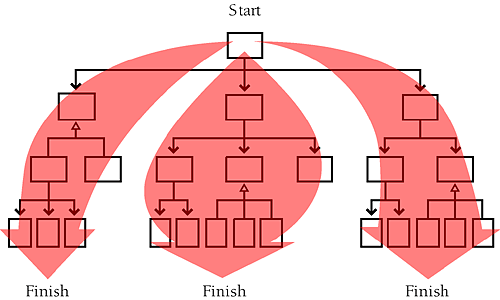 Even though pure top-down integration isn't workable, thinking about it will help you decide on a general approach. Some of the benefits and hazards that apply to a pure top-down approach apply, less obviously, to looser top-down approaches like verticalslice integration, so keep them in mind. Bottom-Up IntegrationIn bottom-up integration, you write and integrate the classes at the bottom of the hierarchy first. Adding the low-level classes one at a time rather than all at once is what makes bottom-up integration an incremental integration strategy. You write test drivers to exercise the low-level classes initially and add classes to the test-driver scaffolding as they're developed. As you add higher-level classes, you replace driver classes with real ones. Figure 29-7 shows the order in which classes are integrated in the bottom-up approach. Figure 29-7. In bottom-up integration, you integrate classes at the bottom first, at the top last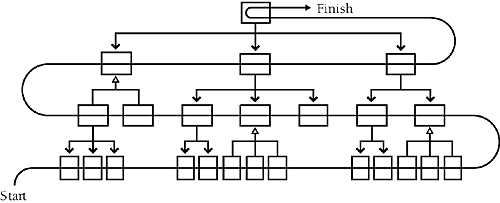 Bottom-up integration provides a limited set of incremental integration advantages. It restricts the possible sources of error to the single class being integrated, so errors are easy to locate. Integration can start early in the project. Bottom-up integration also exercises potentially troublesome system interfaces early. Since system limitations often determine whether you can meet the system's goals, making sure the system has done a full set of calisthenics is worth the trouble. The main problem with bottom-up integration is that it leaves integration of the major, high-level system interfaces until last. If the system has conceptual design problems at the higher levels, construction won't find them until all the detailed work has been done. If the design must be changed significantly, some of the low-level work might have to be discarded. Bottom-up integration requires you to complete the design of the whole system before you start integration. If you don't, assumptions that needn't have controlled the design might end up deeply embedded in low-level code, giving rise to the awkward situation in which you design high-level classes to work around problems in low-level ones. Letting low-level details drive the design of higher-level classes contradicts principles of information hiding and object-oriented design. The problems of integrating higher-level classes are but a teardrop in a rainstorm compared to the problems you'll have if you don't complete the design of high-level classes before you begin low-level coding. As with top-down integration, pure bottom-up integration is rare, and you can use a hybrid approach instead, including integrating in slices as shown in Figure 29-8. Figure 29-8. As an alternative to proceeding purely bottom to top, you can integrate from the bottom up in sections. This blurs the line between bottom-up integration and featureoriented integration, which is described later in this chapter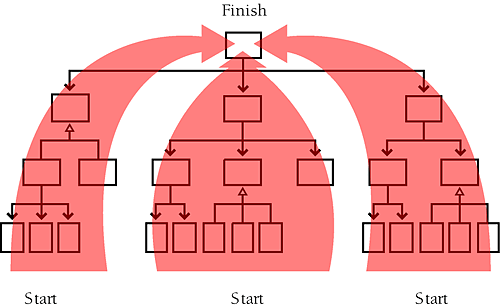 Sandwich IntegrationThe problems with pure top-down and pure bottom-up integration have led some experts to recommend a sandwich approach (Myers 1976). You first integrate the high-level business-object classes at the top of the hierarchy. Then you integrate the device-interface classes and widely used utility classes at the bottom. These high-level and low-level classes are the bread of the sandwich. You leave the middle-level classes until later. These make up the meat, cheese, and tomatoes of the sandwich. If you're a vegetarian, they might make up the tofu and bean sprouts of the sandwich, but the author of sandwich integration is silent on this point maybe his mouth was full. Figure 29-9 offers an illustration of the sandwich approach. Figure 29-9. In sandwich integration, you integrate top-level and widely used bottom-level classes first and you save middle-level classes for last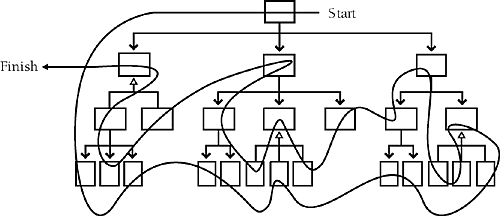 This approach avoids the rigidity of pure bottom-up or top-down integration. It integrates the often-troublesome classes first and has the potential to minimize the amount of scaffolding you'll need. It's a realistic, practical approach. The next approach is similar but has a different emphasis. Risk-Oriented IntegrationRisk-oriented integration is also called "hard part first integration." It's like sandwich integration in that it seeks to avoid the problems inherent in pure top-down or pure bottom-up integration. Coincidentally, it also tends to integrate the classes at the top and the bottom first, saving the middle-level classes for last. The motivation, however, is different. In risk-oriented integration, you identify the level of risk associated with each class. You decide which will be the most challenging parts to implement, and you implement them first. Experience indicates that top-level interfaces are risky, so they are often at the top of the risk list. System interfaces, usually at the bottom level of the hierarchy, are also risky, so they're also at the top of the risk list. In addition, you might know of classes in the middle that will be challenging. Perhaps a class implements a poorly understood algorithm or has ambitious performance goals. Such classes can also be identified as high risks and integrated relatively early. The remainder of the code, the easy stuff, can wait until later. Some of it will probably turn out to be harder than you thought, but that's unavoidable. Figure 29-10 presents an illustration of risk-oriented integration. Figure 29-10. In risk-oriented integration, you integrate classes that you expect to be most troublesome first; you implement easier classes later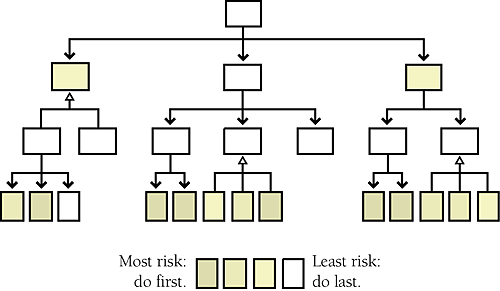 Feature-Oriented IntegrationAnother approach is to integrate one feature at a time. The term "feature" doesn't refer to anything fancy, just an identifiable function of the system you're integrating. If you're writing a word processor, a feature might be displaying underlining on the screen or reformatting the document automatically something like that. When the feature to be integrated is bigger than a single class, the "increment" in incremental integration is bigger than a single class. This diminishes the benefit of incrementalism a little in that it reduces your certainty about the source of new errors, but if you have thoroughly tested the classes that implement the new feature before you integrate them, that's only a small disadvantage. You can use the incremental integration strategies recursively by integrating small pieces to form features and then incrementally integrating features to form a system. You'll usually want to start with a skeleton you've chosen for its ability to support the other features. In an interactive system, the first feature might be the interactive menu system. You can hang the rest of the features on the feature that you integrate first. Figure 29-11 shows how it looks graphically. Figure 29-11. In feature-oriented integration, you integrate classes in groups that make up identifiable features usually, but not always, multiple classes at a time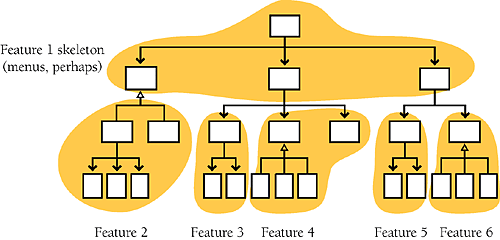 Components are added in "feature trees," hierarchical collections of classes that make up a feature. Integration is easier if each feature is relatively independent, perhaps calling the same low-level library code as the classes for other features but having no calls to middle-level code in common with other features. (The shared, low-level library classes aren't shown in Figure 29-11.) Feature-oriented integration offers three main advantages. First, it eliminates scaffolding for virtually everything except low-level library classes. The skeleton might need a little scaffolding, or some parts of the skeleton might simply not be operational until particular features have been added. When each feature has been hung on the structure, however, no additional scaffolding is needed. Since each feature is self-contained, each feature contains all the support code it needs. The second main advantage is that each newly integrated feature brings about an incremental addition in functionality. This provides evidence that the project is moving steadily forward. It also creates functional software that you can provide to your customers for evaluation or that you can release earlier and with less functionality than originally planned. A third advantage is that feature-oriented integration works well with object-oriented design. Objects tend to map well to features, which makes feature-oriented integration a natural choice for object-oriented systems. Pure feature-oriented integration is as difficult to pursue as pure top-down or bottomup integration. Usually some of the low-level code must be integrated before certain significant features can be. T-Shaped IntegrationA final approach that often addresses the problems associated with top-down and bottom-up integration is called "T-shaped integration." In this approach, one specific vertical slice is selected for early development and integration. That slice should exercise the system end-to-end and should be capable of flushing out any major problems in the system's design assumptions. Once that vertical slice has been implemented and any associated problems have been corrected the overall breadth of the system can be developed (such as the menu system in a desktop application). This approach, illustrated in Figure 29-12, is often combined with risk-oriented or feature-oriented integration. Figure 29-12. In T-shaped integration, you build and integrate a deep slice of the system to verify architectural assumptions, and then you build and integrate the breadth of the system to provide a framework for developing the remaining functionality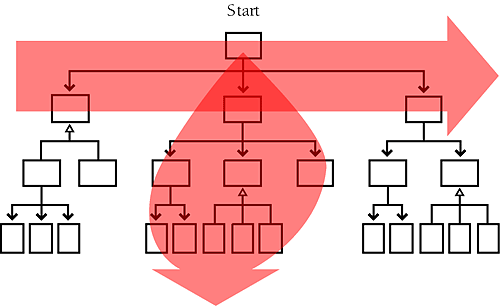 Summary of Integration ApproachesBottom-up, top-down, sandwich, risk-oriented, feature-oriented, T-shaped do you get the feeling that people are making these names up as they go along? They are. None of these approaches are robust procedures that you should follow methodically from step 1 to step 47 and then declare yourself to be done. Like software-design approaches, they are heuristics more than algorithms, and rather than following any procedure dogmatically, you come out ahead by making up a unique strategy tailored to your specific project. |
| < Free Open Study > |
EAN: 2147483647
Pages: 334